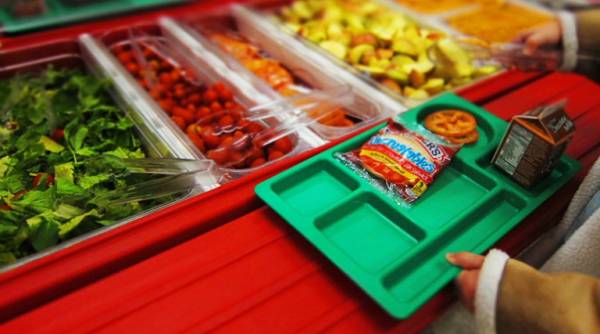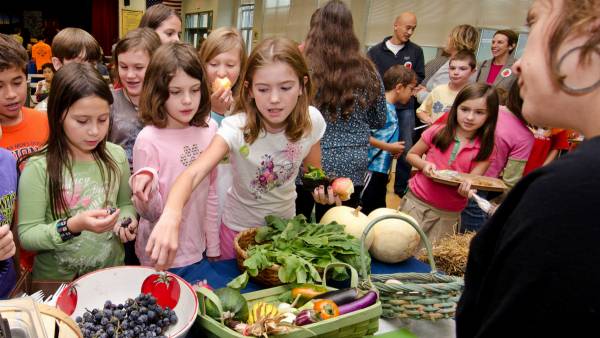Eating and school. These two topics are intertwined in the minds of many adults. Most Americans have vivid, emotional memories of their time in school. We remember the teachers, the smells, the bells, and the rectangular pizzas and sloppy joes sold in the cafeteria.
Eating and school. These two topics are intertwined in the minds of many adults. Most Americans have vivid, emotional memories of their time in school. We remember the teachers, the smells, the bells, and the rectangular pizzas and sloppy joes sold in the cafeteria.
Today, as parents, our mornings are hectic. Between getting ourselves ready for work and our kids ready for school, there’s not a lot of time to spare. Often, the responsibility of providing breakfast falls to the school, where it regularly ends up consisting of something sweet like donuts, frosted cereal, or just plain candy.
These grab-and-go conveniences were created as treats, not daily dietary staples. As they became the bulk of the average American diet, treats evolved into something that passed for sustenance. Thus, for many kids, eating actual food that is devoid of added salt and sugar has become a form of punishment.
How many school-age children today would even recognize these as things to eat?
Do as I Say, Not as I Do
Parents don’t eat real food, so why would their kids? As a nation of food consumers, this is the odd position we have created for ourselves. It makes it hard to even begin the work of positive change in the eating habits of today’s children.
It’s become a difficult necessity for parents to say to their kids, “do as I say, not as I do.” Parents must be okay telling their kids that because they love them, and they want their kids to eat healthy foods. And then parents need to go to the schools (probably after stopping at a drive-thru) and say, “Will you make sure the food served here is better than fast food?”
The Sugar Gauntlet
Let’s examine what our students’ days look like.
Kids arrive at school having gotten inadequate sleep the night before. They grab breakfast: a tray of French toast sticks with buttery syrup and frosted flakes, or an overly sweet caramel-infused coffee drink and a fried breakfast biscuit, and head to class. After sitting through a period, a friend who arrives late brings them a 20oz soda. They sit through a few more classes and swing by the vending machine or the stand selling cookies that smell intoxicatingly delicious. Next stop is the cafeteria for lunch, where they are presented with a few options: a fried chicken breast on white bread with a pickle, nachos, or pizza. All are offered with an apple (yes!) and milk (yes!) or chocolate milk (dangit!).
Why are students being fed nothing but treats all day? America is engulfed in a health crisis due to unhealthy habits that lead to a host of debilitating conditions and diseases. We are systematically reinforcing these bad habits with the food we offer to kids in schools. If instead we attack the health habits in schools, we could cause a change across the entire population within a couple of generations.
The High Costs of Cheap Food
The costs of poor health habits are broad and severe. If you are unsure of the cost to our nations health and vitality, I’d urge you to read my last article on this topic. One study shows that children who grow up deficient of key nutrientsare more likely to have less capacity to focus, less energy, and lower cognitive ability. Poor nutrition leads to more illness, headaches, and general discomfort.
More studies have found that access to quality nutrition, particularly breakfast, can enhance a student’s psychosocial wellbeing, reduce aggression and school suspensions, and decrease discipline problems. Improving nutrition access causes attendance and grades to trend upward, while behavioral issues are reduced. This creates a far better learning environment, along with a far healthier population.
A large percentage of schools across the country provide both breakfast and lunch for their students. In fact, many schools are moving toward serving breakfast in the first period of the day. Imagine the lasting, positive impact on the health of these students if they could be guaranteed two quality meals each day. Would this create classes with students who were more focused and ready to learn? The research indicates it absolutely would.
Let’s Make the Simple Changes First
Getting people to agree that our schools are disturbingly unhealthy places where students are entrenched in negative habits is surprisingly easy to do. Moving people to make specific change is where things get difficult.
It’s all too easy to overcomplicate nutrition or demonize every food choice. Many people hold the common belief that eating healthy is too hard and expensive. They get bogged down in details of trying to figure out what foods are truly the best. It’s easy to become overwhelmed and quit trying, and revert to the status quo. This is why we must simplify.

Rather than be overwhelmed at the enormity of the task, we need to focus on the small, simple changes we can accomplish.
When it comes to simplifying our food choices, sometimes making even a marginally better choice is the best place to start. Apples are better than applesauce. Chicken is better than pizza. We must allow ourselves to make “better” the barometer for now.
If each school had a farm full of dancing chickens, splashing fish, and rows upon rows of fresh produce, providing healthy options to kids would be easy. But this isn’t the case. We need to move closer to the best food possible, while living within the financial and supply restrictions that are the current reality. We want the obvious, easy ways to be better at eating – the low hanging fruit.
The grade for current school nutrition is a D-. It’s not realistic to expect an A+ in the near future, but shooting for a B might be feasible. Kids need better options. They need to eat more fruits, vegetables, nuts, legumes, leaner meats like fish and chicken, and less packaged and processed foods. Any steps in that direction, however small, are still progress.
Create a Food Education System
Brandon Marcello, former director of sports performance at Stanford University, created an amazing dining hall experience where each student could find meal combinations grouped by goals. Marcello color-coded foods to help students to see which were brain foods to help them focus, or which foods were immunity foods with qualities to fight sickness. He pinpointed anti-inflammatory recovery foods, and muscle building foods.
Marcello not only helped clean up the serving options, but he categorized each in a way that was appealing and educational to students. Most students graduate college having never learned how to choose wisely when confronted with a dining hall of options. But these students at Stanford were given a simple path to success.
Strategies like these should be studied and built upon. Cooking classes should be reintroduced as part of the curriculum, and students should learn how to fuel their body properly. Learning how to cook teaches planning and organizational skills that translate to mathematics and reading. These benefits apply to every single student and future generations.

Food education pilot programs, like this one in Arlington, Virgina, are a great start. But they need to be happening all over the country.
Eating Well Isn’t Miserable
To make possible such an overhaul of our approach to school nutrition, it’s important to dispel a common fear. Too many believe that a life without their favorite treats is one of deprivation, devoid of life’s sweet pleasures. But being healthy doesn’t need to be some awful, robotic type of life. Pizza and ice cream cones can still be a part of your reality; they just need to shift from daily occurrences to occasional treats. You will value them more.
Make eating healthy a family adventure to constantly learn and seek more creative food ideas. Empower your children with the knowledge and skills to understand nutrition, how to find healthier options, how to control cravings, and when to enjoy treats. These skills will help them (and you) enjoy life and feel physically vital.
Shape the Path to Better Childhood Nutrition
In their book Switch, Chip and Dan Heath use an analogy to demonstrate how to effect movements of change. They use a rider (rational decision making), an elephant (our emotion), and a path to explain how change is about manipulating these variables.
For example, if I want to start waking up early to stretch because I know my mobility restricts me, that is my rider making that rational goal. Unfortunately, when the alarm goes off I hit snooze. The elephant has taken over. At 5am, I don’t care about mobility, back pain, my future, world peace, or anything else. The elephant wins and I go back to sleep.
The fix is to shape the path. Set three alarms, all which require you to get up and find them. Make sure the last one is right by your foam roller or a mat so you’re more likely to follow through on your plan. End with a reward like a warm cup of coffee that you only get after you finish each day, and you’re on your way to a habit.
If we are going to fix our country’s vast health problems, we need to take advantage of our immense opportunity to shape the path of millions of students. Actions are based on habit, and most of our children are forced through a school system that reinforces the negative habits built by our society. No institution has more influence in shaping our collective habits than schools.
We must act now to help millions. Apathy leads to the perpetual, emotional roller coaster of poor nutrition, and ends with thousands of needless deaths. Let’s create a system to reinforce good habits so that our children live long and happy lives. Change is in our control.
More about Kids Health and Fitness:
- The Real and Present Danger of Overtraining Youth Athletes
- 3 Steps to Improving Your Child’s Eating Habits
- Kids Are Fatter, Sicker, and Slower – What Can We Do About It?
- New on Pulse Beat Fit Today
Photos courtesy of U.S. Department of Agriculture, CC BY 2.0, Wikimedia Commons.






